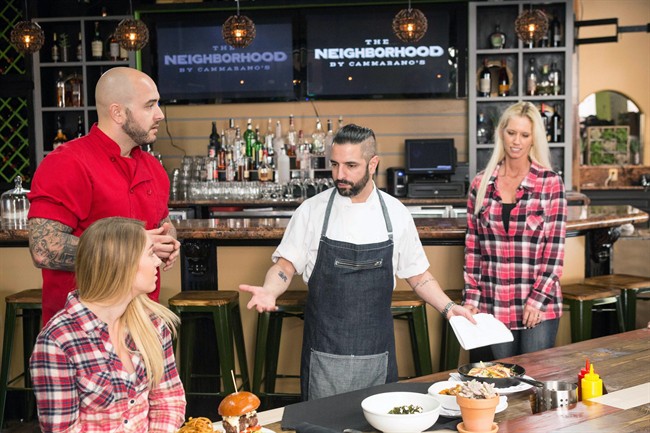LOS ANGELES – The online reviews had filtered in, and they weren’t good: The restaurant Mark Cammarano had invested nearly all of his mother’s retirement money in got just two stars.

So the FYI Network – known for gimmicky reality TV shows like Married at First Sight – offered to step in with Say it to My Face, a new show in which he would meet some of those naysayers face-to-face and confront what they had to say. Then, with the help of two-star chefs, he could try to change their opinions. Cammarano took the gamble.
But gathered in Cammarano’s family-style restaurant in the Los Angeles suburb of Simi Valley, things got testy, quickly.
“I had an arugula and steak salad,” said Ryan Carrillo, a reality TV personality and artistic roller skating champion who’d dined at the restaurant.
“It was literally one of the worst things I have ever ordered in my life. The steak was raw. The quality of the meat was very low.”
“Do you know what carpaccio is?” Cammarano shot back. “It’s raw meat, right?”
“Correct,” Carrillo said. “I said the quality of the meat was low so I couldn’t eat it. Of course the meat was raw.”
Cammarano crossed his arms and looked down, frustration running through his grim but muted expression.
The plot might have seemed perfectly crafted to reel in viewers, but it also hit on a real tension in the food world. Online blogs and user-generated sites like Instagram and Yelp let every customer be a critic – meaning one undercooked dish or forgotten drink can quickly show up online for all the world to see. As newspapers trim their staffs – including expensive restaurant critics – and millennials flock to online-only reviews, the amateur critic has, in many ways, taken centre stage. And that is changing not just the chef-critic dynamic, but the entire restaurant-customer relationship.
Digitally savvy chefs have found ways to build their brands online – chef and food TV star Anthony Bourdain has more Twitter followers than the British monarchy. But for those who are just starting or have no online presence at all, one bad review can indeed be searing. A working paper by Harvard University business administration professor Michael Luca found a one-star increase on Yelp brings restaurants a 5 to 9 per cent increase in revenue, and that independent restaurants benefit most.
“This suggests that online consumer reviews substitute for more traditional forms of reputation,” the study concluded.
To be certain, the bona fide newspaper restaurant critic commands clout. Their numbers, however, have been dwindling. Food sections have shrunk and several notable reviewers laid-off. Meanwhile, the number of blogs dedicated to food has risen exponentially. By one estimate, there were more than 18,000 in 2013.
“Increasingly, newspapers don’t want to spend the money,” said Ruth Reichl, a James Beard award-winning critic and author. “Serious reviews have to be balanced and fair which online reviews aren’t. Every restaurant has its good days and bad days. Serious critics go a number of times to make sure they are getting a fair picture.”
Amanda Hesser, former food editor of The New York Times Magazine and co-founder of Food52, an online hub for cooks, said readers have traditionally looked to the newspaper and magazine reviews for validation in their decision of where to dine, but also for reading pleasure. Readers enjoy what the reviewer has to say and might identify with the sensitivities of a particular critic. In light of the ongoing shift, she said the “reading for pleasure aspect” has become much more important.
“The utility aspect of a review kind of maybe matters less because user-generated reviews exist,” she said.
If there’s any doubt that restaurants still closely watch what the newspaper critic writes, one need only look to Texas, where a group of chefs revolted against a Dallas Morning News critic last year by refusing to let her pay for meals when she visited to review their restaurants – hoping, in turn, that she would be unable to write about them at all. Chefs accused her of running an errant star-system which they said confused customers by making it difficult to distinguish between fine dining and taco stands.
Sal Jafar II, co-owner of Proof + Pantry, which started the revolt, said, “It’s a little dangerous for a person to have that much power.”
He said Yelp and other customer review sites present another sort of difficulty: Those who have a negative experience are often the first to write a review.
“I think that’s the challenge,” Jafar said. “Finding a way to balance that and encourage people, ‘Hey, it’s equally important to let people know you had a good time.”‘
Those are the sort of issues chef Andrew Gruel tries to tackle as co-host of Say it to My Face. In the first episode airing May 9, Cammarano struggles to accept what he sees as an onslaught of unwarranted negativity from critics hiding behind the comfort of their computers.
“They take my dreams and passions and turn it into some type of mockery,” he says in one tense moment on the show.
But Gruel finds nuggets of truth in the reviewers’ critiques: The restaurant’s name is confusing and the ambiance more like a sports bar than a family restaurant. Gruel and his co-host go about revamping the menu, focusing on American comfort foods and lightening up the restaurant with fresh colours and a wall of succulents.
“The days of the angry chef who is like, ‘My way or no way,’ that’s over,” Gruel said. “People driven to write a negative review had something happen to them. Ninety-nine-point-nine per cent of the time, there is always truth.”



Comments